Chapter 21 Blessed
Family Ceremonies
Birthday Celebrations
True Family Birthday Celebrations
True Parents' Birthday.
Observance.
True Parents celebrate their mutual birthday (January 6th) according to the lunar calendar.
Our True Parents' birthday is considered one of the five major Holy Days in our church. It is appropriate for blessed couples and members (on the regional or national level) to send them a card as well as offer a Holy Day donation to the church in their honor. (Refer to chapter 13 Tithing: Holy Day Donations.)
Format.
The format of their birthday celebration is that it is generally commemorated according to a typical Holy Day celebration (refer to chapter 14 Holy Days: Recommendations for Holy Day Celebrations Held on the Center/Departmental/State or National Level).
True Children's Birthdays.
Observance. Although the True Children's birthdays are not considered Holy Days, it is a good practice to remember them with birthday cards (on the regional or national level). Gifts are fitting but not necessary.
A list of the True Children's birthdays is included at the end of this chapter. As their birthdays are celebrated according to the lunar calendar, the dates change each year. It is important, therefore, to refer to the lunar calendar (or a church publication giving the exact dates they will celebrate their birthdays for a given year) each year to discover when to send birthday greetings.
Format.
Blessed couples from the early Blessings, national leaders, department leaders, major leaders and their assistants generally
attend each birthday celebration. Missionaries and other members are often invited as well.
Holy Robes are not worn to the birthday celebration of one of the True Children; the True Family usually wears Western-style clothing.
The majority of the True Childrens' birthdays have been held in the United States during the last twelve years. The living room of East Garden is decorated with many small flags (Unification Church flags and the flags of all nations) strung in rows along the ceiling.
A "Happy Birthday" sign is hung below the mantle and underneath is the name of the birthday child.
Flowers are placed below the altar or offering table.
Offering table.
An offering table is set up; as chairs for the True Parents and the birthday child are placed behind the offering table, it is not placed against the wall.
A candelabra of seven Shimjung, Candles is placed on the right side (facing it) of the offering table. A special meal for the birthday child is prepared and placed on the offering table before the celebration starts. A birthday cake is placed on the left side of the altar.
A special note about the offering table. Offering tables made for each of the True Children's birthdays are extremely bountiful. Please do not try to duplicate such an effort for the birthday celebrations of blessed children. Having the True Parents on earth is so precious; all ceremonies held within their physical lifetimes are special and historic.
The celebrations of the True Children's birthdays are also momentous. Therefore, an abundant offering table is usually prepared for each of their birthdays. During the early years, however, their birthdays were celebrated with very humble altars.
Gifts.
It is the True Parents' tradition to give a special gift to the birthday child. Each leader brings a card and gift representing his or nation or department as well.
The gifts are generally placed on the floor on the right side as one faces the altar and are opened later at a private family gathering.
Prayer for the Birthday Child.
When the True Parents pray for one of the True Children at a birthday celebration, they sincerely thank Heavenly Father for giving their child the blessing of a wonderful year. True Parents humbly ask that God protect their child during the coming year.
[Page 178]
True Parents kiss the cheeks of the birthday child before going behind the offering table to sit in the chairs where the birthday child joins them. Each of our True Parents feeds the birthday child from the special birthday meal. True Parents also eat from this meal. True Parents and the birthday child (when old enough) feed rice cakes to each of the True Children who then pass around rice cakes to all those present.
Cake Cutting.
The birthday cake is cut by the birthday child with the assistance of True Parents.
Picture Taking.
The picture-taking ceremony is quite elaborate. True Parents are photographed with the birthday child. Next, each of the True Children is photographed with the True Parents and the birthday child. All of the men are photographed with our True Parents and the birthday child after which, a similar photograph of all the women is taken.
Birthday Meal.
The True Parents and the birthday child invite some of the major leaders to the dining room for the celebration breakfast (most often either a Korean meal, steak, or chicken). Others form two lines at the buffet table and eat outdoors, in the living room or recreation room. The birthday cake is cut and served.
Participation in the Celebration.
Each person is invited to take some food from the offering table -- cookies, gum, nuts, fruits, etc., before leaving East Garden.
On occasion, Father has spoken, held outings to amusement parks or movies, asked members to sing, or held yute tournaments before the celebration ended.
Birthday Celebrations of True Parents' Grandchildren.
Birthday celebrations of the grandchildren of the True Parents, however, are celebrated in a much simpler fashion than those of True Parents' children.
Blessed Childrens' Birthdays.
History.
The 36 and 72 Couples often could not afford to hold more than very simple celebrations for the birthdays of their children; many times they did not even have the chance or financial means to celebrate them at all. They discovered that the most important focus of a child's birthday is to share the child with Heavenly Father and ask His blessing and protection on him/her for the coming year.
Significance.
Birthdays are anniversaries observing God's gift of life. It is only proper that He is thanked for bestowing a(another) wonderful
year. Even though it was not always easy to recognize that He was working, God protected and guided the child during the past year.
A blessed child celebrates his or her physical and spiritual birthdays on the same day. For this reason, blessed couples must be especially conscious of educating their children from birth. Parents must be aware of the importance of both physical and spiritual nourishment.
Through holding a birthday ceremony for their child couples should redetermine themselves to live the standard of family tradition (the basic contents of The Pledge of the Families) and to internally and externally continue to care for the child God gave them.
Preparation Guidelines.
Below are suggestions of how blessed couples can hold birthday celebrations for their children.
Birthday altar.
Refer to diagrams 21.1 and 21.2 for two manners of preparing the altar and refreshment/offering tables. These are not absolute, nor are they the only two ways possible.
The altar could be set up in much the same way as the Eight Day Dedication Ceremony (refer to chapter 20, Eight Day Dedication Ceremony: Altar), with one major exception described in the following two paragraphs.
Candles.
It is not appropriate to use a Birth Candle on the birthday altar. One or two Shimjung Candles may be used; however, the use of candles is optional. If one Shimjung, Candle is used, place it toward the right side of the picture of the True Parents or True Family (refer to diagram 21.1). If two are used, place one on either side of the picture.
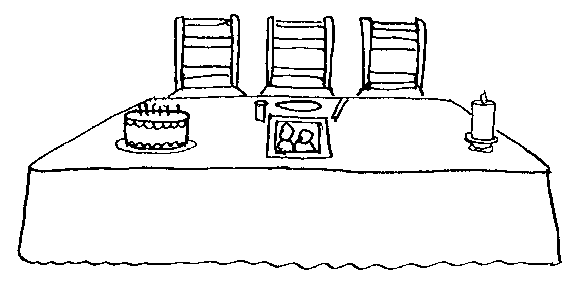
Figure 21-1
21.1. Birthday altar
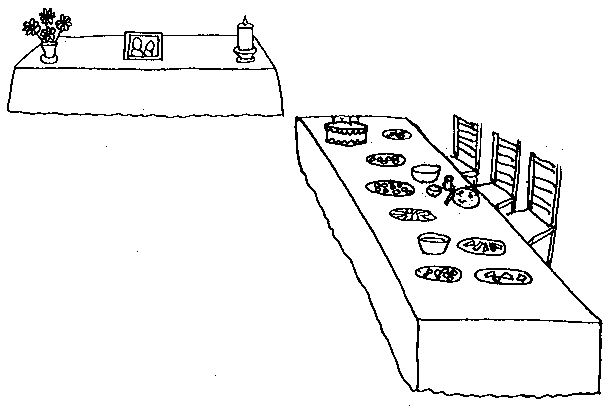
Figure 21-2
21.2. Separate altar and birthday offering table
Chairs.
Chairs may be placed in back of the altar (diagram 21.1) or the refreshment/offering table (diagram 21.2) for both the parents and birthday child.
Food.
Food should be prepared for the birthday celebration. For example, a simple meal might be prepared and/or baskets of fruit, nuts, and candies, as well as a birthday cake. This food can be placed on the altar or on a separate table with refreshments for other members of the family and guests.
If a birthday cake was prepared, it may be placed on the left side of the altar or on the table with the meal and/or refreshments.
Birthday altar dishes.
One may wish to purchase special dishes to be used either for the meal or the formations of fruits, nuts, candies, etc. Dishes for this purpose should be kept and used only for birthday celebrations. New dishes need not be purchased for each child. This is optional based on finances, availability, etc.
Dress.
Both parents and child should wear clean clothes. Color is optional. Wearing Holy Robes on this occasion is a matter of choice.
Attendance of the Celebration.
When a child is very young, it is best to limit the number of people attending the birthday prayer celebration to members of one's trinity and close friends.
One may decide to invite more people to a party or reception with refreshments after (i.e., later in the morning, afternoon, or evening) the prayer celebration, allowing other blessed children near the same age to participate in a celebration, yet not disrupt the prayer service.
Time.
It is recommended that a birthday prayer celebration be held in the morning.
Format.
The child and his/her parents should stand facing the altar and offer a silent prayer, offering their gratitude to God (diagram 2 1 .3).
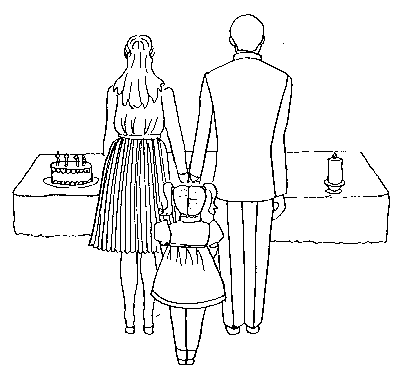
Figure 21-3
21.3. Positions during birthday prayer ceremony
Other members of the immediate family should be in the same line. Guests should be in rows several steps behind.
All those in attendance may offer one full bow.
The parents (and when the child is old enough he/she can join) should recite The Pledge of the Families. The birthday child should join his or her parents either behind the altar or at the refreshment/offering table.
The parents should turn and face the child; the father should place his right hand, and the mother her left hand, on the child's head (diagram 21.4). Either parent, representing the couple, should pray, with words such as the following:
We are grateful to You for giving this child to our family, and grateful that you protected him/her since his/her birth(day). Please bless this child with wisdom, faith, etc. [. . . according to the parents' wishes.] We
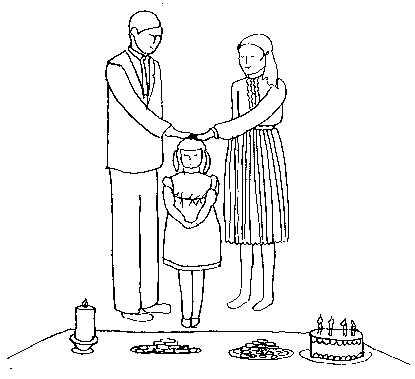
Figure 21-4
21.4. Father places his right hand and mother places her left hand on the child's head
ask that You take care of this child for the coming year and that he/she may become a true son/daughter to You.
The parents may then sit down on the chairs or cushions (either in front or back) of the altar (according to the method used to set up). The child should do one full bow to his or her parents (who represent True Parents).
Both parents may feed the child something from the special food and/ or meal that was prepared. Cake cutting.
One may put candles on the cake and have the child make a wish and then blow out the candles. Afterwards, the cake can be cut by the birthday child, but when the child is too young, parents can assist.
Pictures.
Other members of the family can then join the parents and birthday child, and, if desired, family pictures can be taken.
Distribution of food.
The cake and/or other foods can be shared with the guests at this time or at a reception held later. Gifts.
Following the pattern True Parents have set, it is appropriate for parents to give their child a special birthday gift. Gifts and/or cards can also be given by invited guests. Parents and child should focus on the heart with which it is given, not the cost of the gift.
Opening the gifts.
Parents should prepare a special area where guests may put gifts. It is perhaps most appropriate to open them after the celebration at a private family gathering.
Traditional birthday parties.
During this transition era, it may be desirable to hold a traditional birthday celebration inviting church members (and perhaps a later reception), and to have a separate birthday celebration with non- member friends of the children either later the same day or at a more convenient time. Birthday meal.
If desired, the immediate family may wish to have a special birthday meal (apart from the birthday reception)
Birthday Celebrations of Single Members
Single members do not need to hold elaborate celebrations on their physical or spiritual birthdays because birthdays do not have the same value before one receives the Blessing. It is not improper to celebrate, although the celebration should not be extravagant.
For three years, Father celebrated his birthday with a fast Members should follow this tradition, if possible.
Birthday Celebrations of Blessed Members
Spiritual Birthdays
After the Blessing, a blessed member need not celebrate his or her spiritual birthday. (See this chapter, Blessing Anniversaries.)
Physical Birthdays
Significance.
Blessed members should celebrate their physical birthdays particularly after starting married life. After receiving the Blessing, a blessed member's life becomes more godly and can more easily be claimed by Heavenly Father. Blessed members, therefore, have more authority from God to commemorate their physical birthdays.
Format.
With spouse.
When possible, these celebrations should be held with one's spouse. This birthday prayer service should be held in private early in the morning and can be conducted along the following guidelines:
After a silent prayer of preparation, both offer one full bow toward the altar. They should recite The Pledge of the Families and pray.
Individually.
One may follow the same basic format if celebrating a birthday alone.
Celebration. If the situation permits, it is suggested that a family gathering or outing be planned for the evening. A special meal and/ or birthday cake can be made (perhaps by the children) and shared together. The family might elect to buy a joint gift, as well.
Fasting Condition. As already mentioned, True Father celebrated his physical birthday with a fast for three years. This tradition should be followed by all members, if possible. Many members do this before receiving the Blessing; however, if a member did not, it is acceptable to fulfill such a condition after the Blessing.
A blessed member may also wish to fast together with his or her spouse if he or she is fulfilling such a condition on his or her physical birthday.
Blessing Anniversaries
Significance
The Blessing day of a blessed member becomes his or her actual "spiritual birthday." Our eternal family life begins at the Blessing
ceremony. Be especially conscious of offering thanks to True Parents and Heavenly Father on the advent of each Blessing anniversary. Once again dedicate your couple or family to God and True Parents to become an ideal family. A member should reexamine himself or herself according to the contents of The Pledge of the Families and resolve to uphold its basic principles with even greater determination in the coming year.
Celebration Suggestions
Prayer Service.
In the morning, each blessed couple/member might wish hold a special commemorative prayer service including recitation of The Pledge of the Families.
Anniversary Meeting.
It is suggested that all blessed couples from the same Blessing living in the same locality gather for an anniversary party/meeting in the evening.
Gratitude to True Parents.
If it is possible, each group of blessed couples (on the local, state, regional, or national level) should communicate their appreciation on the anniversary of their Blessing by sending a card and/or gift to the True Parents. Through this expression, we educate our children about the meaning of the Blessing, the position of True Parents, and family tradition.
Other Celebrations
40-Day, 100-Day Ceremonies
Significance.
There is no formal tradition of holding 40-day or 100-day ceremonies after the birth of a child. This practice began in our Korean church as an offering of gratitude to God. The numbers 40 and 100 are providentially significant, and parents may choose to hold a special memorial prayer service to thank Heavenly Father for His grace, protection, and care of their child. However, parents choosing to hold these celebrations must remember that they are not to be regarded as "dedication ceremonies."
After the national level foundation is restored and ideal families live in that environment, the Eight Day Dedication as well as other such ceremonies will no longer need to be held.
Format.
Parents choosing to hold these other ceremonies (40-day, 100-day, etc.), should not follow the content of the Eight Day Dedication Ceremony. The Eight Day Dedication Ceremony is the only ceremony of actual dedication and differs in significance and content
from a 40-day or 100-day celebration. Once a child has been dedicated, he or she belongs to God; it is not necessary to hold a rededication ceremony.
Any other ceremonies could be celebrated according to the basic format of a child's birthday but need not be as elaborate. No special meal or cake needs to be prepared and the altar does not have to include the foods suggested for a birthday celebration. Parents may wish to hold only a simple prayer service.
Preparation.
Refer to the Eight Day Dedication Ceremony for guidelines on altar preparation, suggested grooming and dress code, time, etc.
Altar.
One or two Shimjung Candles may be used. It is not correct to use a Birth Candle on the altar.
Who Should Attend.
Prayer celebration. As the child is still quite young at 40 and 100 days, it is recommended that the number of guests be limited for the prayer service.
Reception.
However, more guests could be invited to a reception held either directly afterwards or later in the day. A reception, however, is not necessary.
Blessed Family Level Commemoration Celebrations
Whenever a member of one's immediate family has reached a certain goal -- graduation, school award, special honor, Blessing, etc. -- a family level celebration (special dinner, outing, family meeting, etc.) may be held. It is important to pray to Heavenly Father in gratitude for assisting the member of the family to attain his or her objective.
Relate even such celebrations to the lifestyle of attendance for blessed families, offering everything to Heavenly Father.
The Blessing
Three Day Ceremony and Forgiveness Ceremony
Due to the very sensitive nature of the Three Day Ceremony (or the ceremony to begin married life), and the instructions and changeability of the qualifications for the Forgiveness Ceremony, please consult a major leader, national leader, regional IW, national Blessed Family Department, or the International Blessed Family Department for the most current information.
Holy Handkerchief
Significance.
The internal significance and use of the Holy Handkerchief is explained in the verbal instructions given for the Three Day Ceremony. They are priceless and should be treated as such. A word about their care will be mentioned here.
When to Receive.
Holy Handkerchiefs are given only to members who have gone through both the Engagement and Holy Wine Ceremonies and are handed out individually at that time.
Preservation.
NEVER wash a Holy Handkerchief.
The Holy Handkerchief has been sprinkled with Holy Wine and may be wet or slightly damp when received. It is important to dry it out BEFORE putting it away.
Be sure that it is stored in some type of material (plastic bag, for example). Do NOT put it away without covering it.
Do not write your name on the Holy Handkerchief itself; it is important that your name is clearly marked on the outside of-the package. (Place it in an envelope with your name on the outside, if desired.)
Each person has the responsibility to store his or her Holy Handkerchief in a safe place.
If fiancées or spouses store their Holy Handkerchiefs in the same place, the handkerchiefs must NOT be mixed up. Clearly mark both packages with the individual names.
Do NOT divide your Holy Handkerchief. (See below.)
If A Holy Handkerchief Is Lost. One cannot have the Three Day Ceremony without his or her own Holy Handkerchief. Dividing a Holy Handkerchief is not acceptable, nor is using only one. However, loss of a Holy Handkerchief is taken seriously and receiving a second one requires a condition of indemnity (tang gam).
Consult a major or national leader, regional IW, national Blessed Family Department, or the International Blessed Family Department for direction. In the Case of Reblessing or Rematching. The Holy Handkerchief originally received is still valid and should be used.
Holy Handkerchiefs of members who have left the Unification Church should be sent to the International Blessed Family Department.
Blessing Clothes
Care of Engagement and Wine Ceremony Clothes.
The clothes a member wore to the Engagement and Wine Ceremonies should be kept. It is proper to wear them afterwards; however, they should not be given or thrown away if they become too worn.
For their historical value, store them, marking them with the date you participated in these ceremonies.
Blessing Clothes.
Standard requirements.
The clothing requirements (suits, wedding dresses) requirement (color, style, etc.) may change with each Blessing; therefore, no absolute standard will be mentioned here.
Purchase new clothing.
If possible, all clothing, including undergarments, gloves, shoes, socks, ties, etc., worn to the Blessing should be newly purchased.
Undergarments.
Underclothes worn at the Blessing may be used again.
Gloves.
Gloves worn at the Blessing would be appropriate to use on other occasions (refer to chapter 18, Holy Robes: Gloves). Gloves should be stored with Holy Robes.
Men's Clothing.
Care.
The clothes worn at the Blessing should be kept and stored properly.
Reuse.
Mens' Blessing suits, ties, shirts, and shoes may be worn again for Pledge services, Sunday services, or other special occasions. They should not, however, be worn on a daily basis.
Use at Holy Day celebration.
It is not permissible to wear these clothes under a Holy Robe if a member is attending a Holy Day celebration with True Parents or their representatives. Each item of clothing worn on such occasions must be completely white.
Women's Clothing.
Care.
The clothes worn at the Blessing should be kept and stored properly.
Reuse.
If women were blessed in a white Korean chima chogori, they may use this to satisfy the Korean-style clothing requirement for use under the Holy Robe. (See chapter 18, Holy Robes.)
Women who wore Western-style wedding dresses should try to obtain a chima chogori for use under the Holy Robe. If this is impossible, she may use her wedding dress under the Holy Robe during the Three Day Ceremony.
Care of Engagement, Wine Ceremony, and Blessing clothes in the event of rematching.
If a blessed member must go through a rematching, he or she may wish to select different clothes for the matching/engagement and Wine Ceremony. However, if it is not possible due to finances, time, etc., it is an individual choice whether or not to wear the same clothing. The clothes are a member's personal property, and if he or she has strong feelings about throwing them away or destroying them, it is a matter of choice.
A woman must purchase a new wedding dress according to the style used in the next Blessing.
A man may wish to use the suit used at the first Blessing if the standard of color, etc., has not changed.
Blessing Ring
Wearing. The blessing ring is traditionally worn on the third (diagram 21.5-A) or middle (diagram 21.5-B) finger of the right hand for both men and women.
Loss. If a member loses his or her Blessing ring, he or she should purchase a new one.
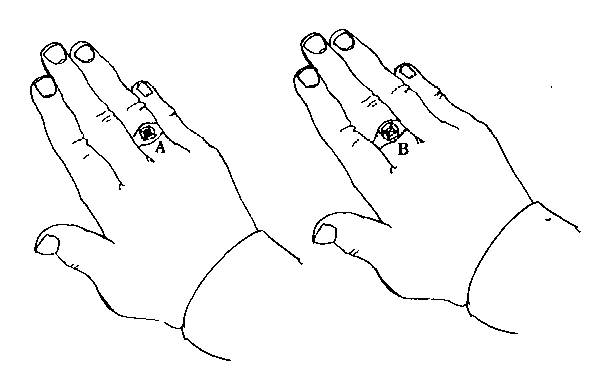
Figure 21-5
21.5. Blessing ring may be worn on either finger of the right hand (indicated by A or B)
Wedding and Engagement Rings
One of the most precious and significant mementos of the Blessing is the Blessing ring. However, if one desires to purchase engagement rings and additional wedding bands for individual reasons, the decision is with the couple.
Birthdays of the True Children
Name Meaning of the name Lunar Birthday
Boys
Hyo Jin Nim - March of Filial Piety, Devotion and Love - 12-03-62
Heung Jin Nim - March of Prosperity - 10-23-66
Hyun Jin Nim - March of Light, Manifestation of Light - 04-10-69
Kook Jin Nim - March of the Nation (last child born Korea) - 06-14-70
Kwon Jin Nim - March of Authority and Power (born U.S.A.) - 01-20-75
Young Jin Nim - March of Glory - 05-17-78
Hyung Jin Nim - March that Everything Goes Well - 08-06-79
Girls
Ye Jin Nim - March of Honor, Respect, Fine Arts - 12-11-60
In Jin Nim - March of Great Virtue, Nobility - 07-18-65
Un Jin Nim - March of Grace, Blessing of God - 11-23-67
Sun Jin Nim - March of Goodness - 06-15-76
Yeon Jin Nim - March of Beauty - 01-03-81
Jeung Jin Nim - March of Heart - 04-23-82
